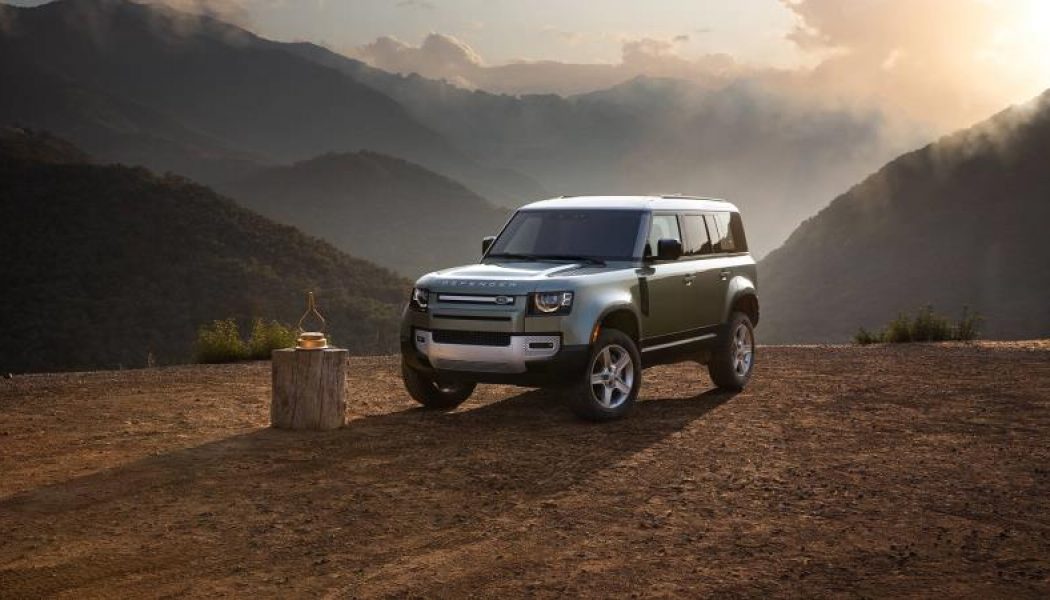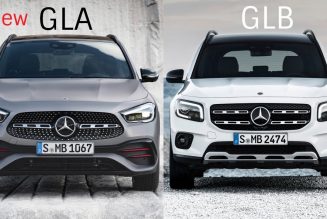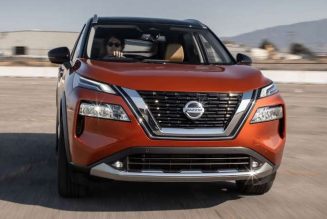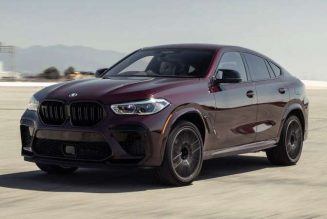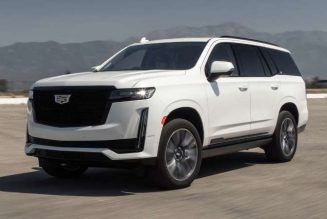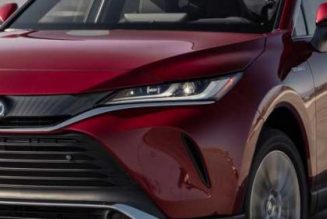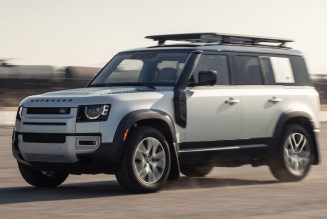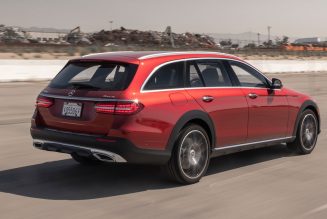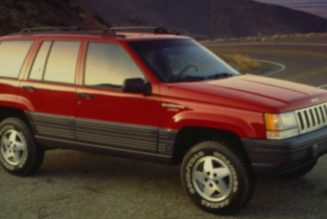You would be forgiven for assuming the judges of our 2021 SUV of the Year competition simply walked around the parking lot filled with 28 new and refreshed SUVs and pinned the award on the Land Rover Defender without starting a single vehicle. Unlike most of this year’s field, the all-new Defender actually looks the part of a proper sport utility vehicle.
Sport utility vehicles as we know them have transformed from go-anywhere tools to mall-crawling tall wagons and minivan substitutes. Most vehicles we refer to today as SUVs are actually CUVs—car-based crossovers lifted up in the air a few inches, not for ground clearance but because people like to sit up high.
There is no mistaking the Land Rover Defender for one of these poseurs. That said, the Defender itself has metamorphosed to play in the current times. It ditches the decades-old steel frame of the previous L316 version (itself an evolution of the original “Series” Land Rovers, a chromosome or two removed from a farm tractor). Instead, the new L663 Defender sports an aluminum unibody. Perhaps most shocking of all to loyalists and off-roading aficionados, the live axles have been dropped in favor of fully independent suspension. How do you say “sacrilege” in the Queen’s English? Yet if asked to traverse great swaths of rutted, tumbling African trails, the Defender is a steadfast, undeterred companion and guide.
It seems like a simple decision to hand the Golden Calipers to the lads from Solihull. But not so fast. Merely being a rough-and-tumble “real” SUV does not automatically earn you SUV of the Year.
Even during this global-crisis reality, we put all 28 contender vehicles (including variants) through a slew of instrumented and evaluative tests, checking everything from acceleration and handling to second-row passenger space, from fuel economy to infotainment intuitiveness.
In so doing, we cut our list to six finalists then dove back in for a round to test (among other things) rough road ride, switchback cornering, and smart cruise control at freeway speeds.
At the end of a less-than-ideal process, one SUV stood roof rack and rearviews above the rest. This year, the 2021 SUV of the Year result is not only the obvious one, but it’s also the surprising one and the feel-good one.
Why Obvious?
There are certain vehicles you can feel are special after only 50 feet of driving. Or, if you’re features editor Christian Seabaugh, “Three feet is all the Defender needs to put a smile on your face.” I remember having this feeling after 30 seconds in a Dodge Challenger Hellcat. Same thing happened with a Bugatti EB110 SS and a Ford Fiesta ST. The type of vehicle doesn’t matter as much as the intent behind the vehicle. After 100 yards across a parking lot leading to the drive route, I radioed to my fellow judges, “Can we just call the Land Rover the winner and head home?” Cheeky, as the Brits would say? You bet your bubble and squeak. However, I had a point.
“Part of the word ‘transportation’ is not just the driving but the feeling of being transported,” editor-in-chief Mark Rechtin said. “The moment you get into a Land Rover Defender, you are transported. Every design element gives the aura of journey, safari, moving outward into the world with courage.” I had a similar thought in my own notes: “The Defender makes me feel like going on an adventure. Preferably across an unpaved continent.” Features editor Scott Evans was even more succinct: “It has a snorkel. You can hear it sucking in air when you accelerate. Sold.”
Why Surprising?
Speaking for me, I was predisposed to think the new Defender wouldn’t be any good. Based on what, though?
I had convinced myself that the removal of its live axles, especially the rear one, would render the Land Rover neutered. My two favorite luxury off-roaders—the Mercedes-Benz G 550 and Toyota Land Cruiser—both employ a rear stick axle and feature unassailable capability.
I had also convinced myself that Land Rover was simply going to dress up the Defender as a serious off-roader, not be one. I know others feel the same way, including possibly some of you and specifically everyone on Instagram.
Then our young Seabaugh proved all us haters and doubters wrong when he drove a Defender 110 across Namibia—498 miles off-road, only 2 miles on pavement. Full disclosure: I ran into a pack of prototype Defender mules easily handling the Poison Spider Trail in Moab, Utah. That’s about as tough of a rock crawling adventure as a stock vehicle can handle.
So even though I knew, I didn’t really know. Put a better way, I didn’t choose to believe. Anyhow, I’m pleasantly surprised at how wrong I was.
Why Feel-Good?
The Defender, like the G-Wagen and Land Cruiser, as well as the 900-pound mountain goat of the off-road world, the Jeep Wrangler, is an icon. Car enthusiasts want icons to be great, not just good. There is a reason why so many owners and admirers have loved them as hard for as long.
If the new Defender was just OK or even a complete betrayal of its roots, I suppose Land Rover would sell enough on looks alone to justify the development cost—but the rig’s status as a true icon would be forever over. Fears unjustified.
“I’m glad I’ve lived long enough to see the return of the Land Rover Defender,” head of editorial Ed Loh said. “I’m also happy to report that it’s good. Really good. Definitely the most emotional choice here. No vehicle made me smile more.” Added Seabaugh: “Man, this thing just puts a smile on my face.” See? The Defender just feels good. It feels right.
But a vehicle cannot earn an SUV of the Year win on emotion alone. It must show excellence against our six key criteria.
Advancement in Design
I’ll admit that when I first saw pictures of the new Defender, I was not a fan. Then I stumbled into one at an auto show (remember those?), and my opinion did a 180. There’s a scale to the vehicle that you simply can’t grasp from photos.
“Looks way better in person than in the pictures,” MotorTrend en Español managing editor Miguel Cortina said. “The design is futuristic, modern, iconic, and outstanding. It incorporates the Defender’s DNA with the modern design cues of today.” From whatever angle you view it, the Defender stands out and lets you know exactly what it is, though perhaps the rear is where the most is happening.
“Stand behind this car, and you’re struck by the width,” Buyer’s Guide director Zach Gale said. “What a great design that makes you focus first on the straight lines. Then it goes out a little bit for the shoulders, and then there’s another bulge outward for the wheelwells. There are so many interesting angles on this Defender.” Perhaps most important, no matter where you’re standing, you know what you’re looking at.
I personally found the interior design to be the best part. Climbing into the new Defender feels like you’re sitting inside of a real SUV. Not to fall too far down the True Scotsman logical fallacy rabbit hole, but I don’t think I’m offending anyone by stating that the Land Rover Defender feels like a more authentic sport utility vehicle than, say, the Mazda CX-30.
“The commanding seating position is impressive, especially considering how low its center of gravity is,” Rechtin said. The design is also a breath of fresh air, Cortina said: “Land Rover designers thought about a bunch of details to make this interior the way it is. The exposed bolts, the multifunction center console, the intelligent cubbies—all of it contributes to a great-looking interior.”
Miguel is not alone with his sentiment. “The interior masterfully balances functionality with style,” Seabaugh said. “I especially love the riveted door cards with the exterior color accenting the black and tan trim. My favorite bit of the interior is the structural magnesium crossbar.” We could go on and on—and will, with Gale: “Body color on the interior door panel is a spectacular detail. Love it. Never have I been so happy to see hard trim on a door panel.”
As I was getting coffee one morning, a masked Range Rover owner sauntered over to have a peek inside the Defender. “There are so many places to put things,” she said. I agree with her. I was able to place my wallet and sunglasses case on the left side of the TFT instrument panel. On the right side, the elongated parcel shelf that runs behind the infotainment screen can hold an umbrella (or a small rifle if you are traversing the Darién Gap). Plus, it has a USB port hiding back there. Actually, the inside of the Defender is festooned with 15 charging ports of all kinds: cigarette lighter outlet, USB, USB-C, wireless, and good old Yankee 110V. The center console has a Honda-expertise level of cubbyhole functionality. The storage possibilities seem endless.
Being a Land Rover, it has to carry luxury touches, such as firm yet supportive leather seats, satellite radio, and a glorious Meridian stereo. Then again, as Evans found: “The plastic in a lot of places is real cheap-looking. But it’s also meant to get abused in harsh environments, so it’s not supposed to be super nice. That’d be like an oil rig worker wearing a bow tie.”
The Defender’s larger-than-you-think exterior results in a spacious interior. “This is a great car for people who like to wear hats,” the 6-foot-4 Gale said.
The Defender’s commodiousness continues behind the front seat, sorta. “The middle row was surprisingly roomy,” Seabaugh said. But behind that middle row, well, Rechtin nailed a Defender weak point: “Third-row entry and exit is entertaining at best, and third-row seat room is definitely for a non-claustrophobic child.”
(Fear not, those of you who require an adult-size third row and seating for eight. Land Rover hasn’t announced the Defender 130 yet, but you can expect a Defender with the same wheelbase but an extended rear overhang and a qualitatively improved third row in about a year or so. Until then, take solace in the fact that with the optional third row folded flat, there’s a ton of room for stuff.)
Engineering Excellence
This was the most surprising part to me. See, I’ve driven old Defenders, more than a few. And although charming to a degree, they are crude, slow, miserable, and uncomfortable. In a word, agricultural. The only thing they have in common with a luxe Range Rover is the badge. Yes, you could take one across the Australian Outback blindfolded, but you’d be bruised, banged up, and having a whinge about how miserable the whole ordeal was.
The new L663 Defender’s engineering, on the other hand, blew us all away. “I love this engine and transmission,” Evans said about the 395-hp, 406-lb-ft 3.0-liter turbocharged and electric supercharged I-6 mated to an eight-speed ZF auto sending power to all four wheels. “This thing gets up and runs with no problem. Anyone who thought it needed a V-8 is mistaken.”
Much more surprising to me was the floating-cloud way the Defender rode, especially considering how tortuous its predecessor’s ride was. Seabaugh, one of our most avid off-roaders, had much to say: “Simply put, I’ve never driven a serious off-roader that was this capable on-pavement. The Chevy Colorado ZR2 and Ford F-150 Raptor come close, but this takes the cake. The Defender feels supple yet planted. It steers shockingly well, with fingertip light (as is classic British style) but still talkative steering—amazing considering the tires on this thing.”
Evans concurred: “It rides surprisingly well for a big off-road truck. A little stiff but really takes the big hits well.” Loh confirmed: “And ooh baby, that air suspension. How does a vehicle this big and trucky drive so small and smooth?” I’d chalk it up to excellent engineering.
Performance of Intended Function
Despite all that praise, this is the criterion the new Defender hammers home the hardest. I mentioned how the Defender feels like an authentic SUV, a rare commodity in 2020. The damn pandemic kept us from doing our normal off-road loops, though we did all sit around a Zoom campfire while Seabaugh regaled us with tales of hardcore off-roading across Africa.
Plus, we’ve seen the James Bond Defender commercial. Dozens of times. This week. What strikes me the most reading through our driving impressions is just how successful Land Rover was at getting the Defender exactly right.
“The G-Wagen better watch out—this is the most direct challenger it’s had in years,” Gale said. Although this vehicle is still clearly a Defender and carries its heritage proudly, it’s not a slave to the past like the G-Wagen and Wrangler are.
“The Defender has a huge amount of personality,” Evans said. “It’s one of those awesome off-road trucks like the Ford Raptor or the Ram Power Wagon that makes you just want to drive over everything you can find.” What about the aforementioned 900-pound mountain goat? “You have to admit that in comparison to a Wrangler Unlimited, it pencils out OK. You get nearly all the off-road tricks out of the box. Plus, the Defender can seat seven, it rides and handles better, it’s quieter inside, and it’s faster.”
Value
For all this wonderful design, capability, and (yes) luxury, it’s about time we mentioned the Land Rover Defender’s ace in the six-key-criteria hole: value. Defenders for the 2021 model year start at $47,450. Crazy, I know, and at least $20K cheaper than I would have thought. True, that’s for the not-quite-on-sale-yet two-door Defender 90, but the four-door 110 with a 2.0-liter turbo inline-four can be yours for $51,850.
That’s certainly not cheap, but compared to the vehicles mentioned earlier, it’s a relative steal. Even when compared to the Wrangler, it’s a great value, what with four-door Rubicons (the ones with off-road chops to match the Defender) routinely coming in (to our office at least) over $60K. Even our pretty much loaded 110 SE Defender is a solid value at $82,575 as tested—that’s a Rolex less than the aging Toyota Land Cruiser and nearly two-thirds the price of the $131,895 Mercedes-Benz G 550. For good measure, from acknowledged Land Cruiser fanboy Loh: “The Defender does put the Toyota a bit on the trailer, especially when you look at the price. It feels like you get a lot of really cool stuff at $82,575, versus a $91,000 mono-spec, decade-old Land Cruiser Heritage.”
Efficiency
Admittedly, the Defender does worse here than against any of the other criteria. Sure, there is an available 2.0-liter turbo inline-four, but that actually drops the 2020 EPA numbers from 17/22 to 17/20 mpg. The I-6 is a mild hybrid with a 48-volt electric supercharger, after all. Should you go for the Defender 90 with the 2.0-liter, you’ll eke out 21 mpg highway. That said, compared to the G-Wagen and Land Cruiser, the Defender is a Prius.
Safety
This one’s tricky, as the Defender has not been crash-tested. Equally frustrating, the Discovery it’s based on has never been tested, either. As technical director Frank Markus explained, “In a rare departure from form, our government doesn’t care enough about rich people’s safety to test low-volume expensive vehicles.”
A current-generation L462 Discovery was crash-tested by the EU’s Euro NCAP safety body, where it scored five stars. Two issues with that. First, NCAP’s five stars do not directly translate to NHTSA’s five stars. (For instance, part of that rating is pedestrian safety.) Second, the Defender rides on the D7x platform, a modified version of the Discovery’s aluminum-intensive D7u structure. Translation: Using the NCAP results from the Discovery for the Defender would be apples to pears. All that said, 5,719 pounds of vehicle is a pretty good passive defense.
As far as active safety, the Defender comes well stocked. Lane keeping assist, blind-spot assist, emergency braking, driver condition monitoring, and the list goes on. My favorite is wade sensing, which uses ultrasonic sensors in the door mirrors to provide a real-time pictograph of the water you’re fording. It’s the gotta-have-it safety feature for 2021.
A Word of Caution
We would be remiss if we didn’t mention that our time with the Defender was not trouble free. A middle-row seat had a rattle that could only be solved by folding it down. Moreover, the satellite radio froze in the middle of a Vampire Weekend song and refused to reboot. We also had a second Defender (not a part of our SUV of the Year evaluation) that suffered a dead starter. At freeway speeds, the aluminum roof rack had a sonic vibration akin to an angry air compressor.
We interrogated Land Rover about why this all happened, because obviously we don’t want to look like fools. Land Rover responded that both Defenders were early-build vehicles, and the more production-representative versions they wanted to ship over were held up because of COVID-19. Sounds plausible, as I’ve personally had parts literally fall off of pre-production and early-build cars more times than I can count. To paraphrase Elon Musk, making cars is hard.
The world is familiar with Land Rover’s (ahem, how to put this genteelly) spotty reputation for reliability. Then again, our experience is anecdotal, not statistical. We had a long-term Range Rover Velar that didn’t so much as squeak over a year’s time in our hands. That same unwavering reliability also held true for our long-term Alfa Romeo Giulia—our 2018 Car of the Year—even after half the internet expertly howled about how it would surely leave us stranded. We’ve also had more than a few Audis, BMWs, Cadillacs, Porsches, Telsas, Lexuses, and the like break down on us during testing. As with all things concerning your wallet, caveat emptor.
Winner, Winner, Chicken Dinner
To conclude, summarize, and even proselytize, the new Land Rover Defender bowled us over: the design, both inside and out; the wonderful synchronization of the stout engine and yeoman transmission; the exceptional ride quality; its ambient nature; the baked-in, go-anywhere-on-the-planet capability; and its amazing value.
It’s a heady and compelling mixture. Then there is the element that’s not an official part of our six criteria but that I always lobby for: Winners should have some sort of X-factor, a secret sauce that reminds us why we chose to write about cars instead of refrigerators or computers. We love cars, trucks, and in this case SUVs. The Defender has these ineffable qualities in spades. The Defender received every first-place vote but one. See? It’s special.
Seabaugh accurately summarized our thoughts: “Ignoring emotion, how can the Land Rover Defender not be our winner? No other vehicle here hits our six criteria so squarely in the mouth.” And as Mike Tyson said and as the SUV segment is about to discover, everybody has a plan until they get punched in the mouth. Stellar work, Land Rover. We doff our pith helmets.
| 2020 Land Rover Defender 110 SE | |
| DRIVETRAIN LAYOUT | Front-engine, 4WD |
| ENGINE TYPE | Turbocharged/e-supercharged I-6, alum block/head, plus electric motor |
| VALVETRAIN | DOHC, 4 valves/cyl |
| DISPLACEMENT | 182.8 cu in/2,996 cc |
| COMPRESSION RATIO | 10.5:1 |
| POWER (SAE NET) | 395 hp @ 5,500 rpm (gas) + 10 hp (est elec); 395 hp (comb) |
| TORQUE (SAE NET) | 406 lb-ft @ 2,000 rpm (gas) + 55 lb-ft (elec); 406 lb-ft (comb) |
| REDLINE | 6,800 rpm |
| WEIGHT TO POWER | 14.5 lb/hp |
| TRANSMISSION | 8-speed automatic |
| AXLE/FINAL-DRIVE/LOW RATIO | 3.55:1/2.27:1/2.93:1 |
| SUSPENSION, FRONT; REAR | Control arms, air springs, adj shocks, anti-roll bar; multilink, air springs, adj shocks, anti-roll bar |
| STEERING RATIO | 12.6-17.6:1 |
| TURNS LOCK-TO-LOCK | 2.8 |
| BRAKES, F; R | 14.3-in vented disc; 13.8-in vented disc, ABS |
| WHEELS | 8.5 x 20-in cast aluminum |
| TIRES | 255/60R20 113H M+S Goodyear Wrangler LR |
| DIMENSIONS | |
| WHEELBASE | 119.0 in |
| TRACK, F/R | 67.1/66.9 in |
| LENGTH x WIDTH x HEIGHT | 187.3 x 78.6 x 77.4-80.3 in |
| GROUND CLEARANCE | 8.6-11.5 in |
| APPRCH/DEPART ANGLE | 30.1-37.5/37.7-40.0 deg |
| TURNING CIRCLE | 42.1 ft |
| CURB WEIGHT | 5,719 lb |
| WEIGHT DIST, F/R | 49/51% |
| TOWING CAPACITY | 8,200 lb |
| SEATING CAPACITY | 7 |
| HEADROOM, F/M/R | 40.6/40.4/40.7 in |
| LEGROOM, F/M/R | 39.1/38.4/20.5 in |
| SHOULDER ROOM, F/M/R | 60.8/59.2/48.3 in |
| CARGO VOLUME BEH F/M/R | 69.0/34.6/11.4 cu ft |
| TEST DATA | |
| ACCELERATION TO MPH | |
| 0-30 | 2.1 sec |
| 0-40 | 3.3 |
| 0-50 | 4.7 |
| 0-60 | 6.5 |
| 0-70 | 8.4 |
| 0-80 | 10.9 |
| 0-90 | 13.8 |
| 0-100 | 17.4 |
| PASSING, 45-65 MPH | 3.6 |
| QUARTER MILE | 14.9 sec @ 93.2 mph |
| BRAKING, 60-0 MPH | 129 ft |
| LATERAL ACCELERATION | 0.67 g (avg) |
| MT FIGURE EIGHT | 30.1 sec @ 0.54 g (avg) |
| TOP-GEAR REVS @ 60 MPH | 1,500 rpm |
| CONSUMER INFO | |
| BASE PRICE | $63,600 |
| PRICE AS TESTED | $82,575 |
| STABILITY/TRACTION CONTROL | Yes/Yes |
| AIRBAGS | 6: Dual front, front side, f/r curtain |
| BASIC WARRANTY | 4 yrs/50,000 miles |
| POWERTRAIN WARRANTY | 4 yrs/50,000 miles |
| ROADSIDE ASSISTANCE | 4 yrs/50,000 miles |
| FUEL CAPACITY | 23.8 gal |
| EPA CITY/HWY/COMB ECON | 17/22/19 mpg |
| ENERGY CONS, CITY/HWY | 198/153 kW-hrs/100 miles |
| CO2 EMISSIONS, COMB | 1.02 lb/mile |
| RECOMMENDED FUEL | Unleaded premium |
